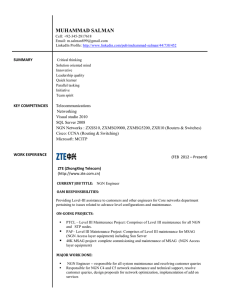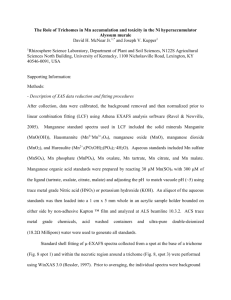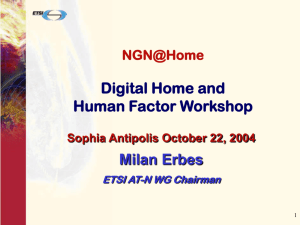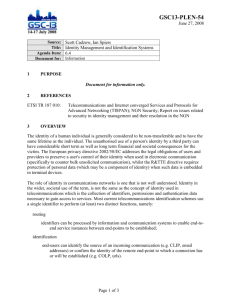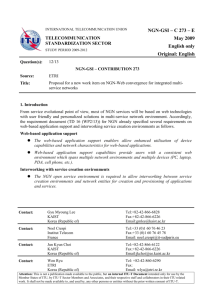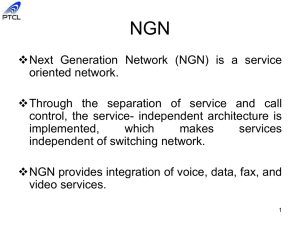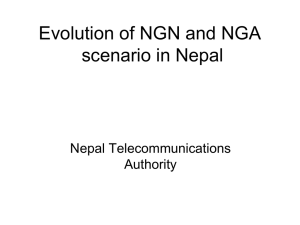Template for Electronic Submission to ACS Journals
advertisement
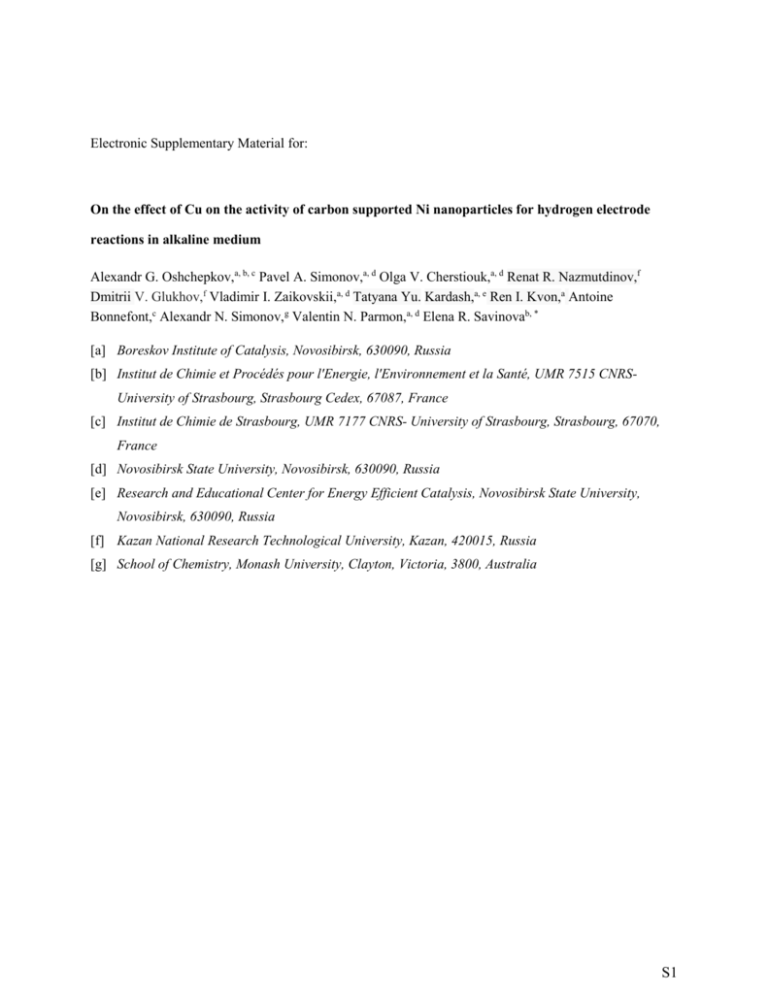
Electronic Supplementary Material for: On the effect of Cu on the activity of carbon supported Ni nanoparticles for hydrogen electrode reactions in alkaline medium Alexandr G. Oshchepkov,a, b, c Pavel A. Simonov,a, d Olga V. Cherstiouk,a, d Renat R. Nazmutdinov,f Dmitrii V. Glukhov,f Vladimir I. Zaikovskii,a, d Tatyana Yu. Kardash,a, e Ren I. Kvon,a Antoine Bonnefont,c Alexandr N. Simonov,g Valentin N. Parmon,a, d Elena R. Savinovab, * [a] Boreskov Institute of Catalysis, Novosibirsk, 630090, Russia [b] Institut de Chimie et Procédés pour l'Energie, l'Environnement et la Santé, UMR 7515 CNRSUniversity of Strasbourg, Strasbourg Cedex, 67087, France [c] Institut de Chimie de Strasbourg, UMR 7177 CNRS- University of Strasbourg, Strasbourg, 67070, France [d] Novosibirsk State University, Novosibirsk, 630090, Russia [e] Research and Educational Center for Energy Efficient Catalysis, Novosibirsk State University, Novosibirsk, 630090, Russia [f] Kazan National Research Technological University, Kazan, 420015, Russia [g] School of Chemistry, Monash University, Clayton, Victoria, 3800, Australia S1 SUPPLEMENTARY MATERIALS CONTENT Fig. S1 showing cyclic voltammograms for the Ni/C, Ni0.50Cu0.50/C catalysts and carbon support Vulcan XC-72 Fig. S2 showing how the electrocatalytic activity is determined using Ni0.95Cu0.05/C catalyst as an example Fig. S3 showing TEM image for the Ni0.95Cu0.05/C catalyst with low magnification Fig. S4 showing TEM images for the Ni90Cu10/C, Ni0.70Cu0.30/C, Ni0.50Cu0.50/C catalysts with elemental mapping Experimental details for XP spectra processing Fig. S5 showing Ni2p and Cu2p XP spectra for the Ni/C, Ni0.95Cu0.05/C, Ni90Cu10/C and Ni0.80Cu0.20/C catalysts Experimental details for MC simulations Table S1 listing parameters of the pair Morse potential Fig. S6 showing simulated structures obtained at 427 ºC S2 Fig. S1 Cyclic voltammograms for the Ni/C (solid), Ni0.50Cu0.50/C (dash) catalysts and the carbon support Vulcan XC-72 (dot) at 25 ºC in Ar-saturated 0.1 М NaOH solution at a scan rate of 20 mV s-1. Currents are normalized by the mass of the carbon support Fig. S2 (a) and (b) demonstrate the quality of fitting of the micropolarisation and of the Tafel potential interval, respectively, for the Ni0.95Cu0.05/C sample S3 Fig. S3 TEM image of the Ni0.95Cu0.05/C catalyst at low magnification S4 Fig. S4 HAADF-STEM images of the Ni0.90Cu0.10/C (a), Ni0.70Cu0.30/C (b) and Ni0.50Cu0.50/C (c) catalysts with elemental mapping of Ni (green) and Cu (red) atoms (a1, b1, c1, correspondingly) S5 XP spectra processing The surface concentrations of the elements (C, O, Ni, and Cu) were calculated from the integrated intensities of the corresponding photoelectron peaks (see Fig. S5 for Ni2p and Cu2p spectra) using atomic sensitivity factors tabulated in [1]. For estimating the Ni0 contribution, the Ni2p doublet for the metallic state was fit with 6 components and subtracted from the experimental XP spectra. It should be noted that XPS data for Ni oxides reported in the literature make the further spectra deconvolution rather ambiguous. To simplify the curve fitting procedure only the Ni2p3/2 part of the doublet was treated, and the fitting process was constrained by assuming that the binding energy of the O1s peak related to Ni2+ oxide is close to 529 eV [2], while O1s spectra for hydroxyls, carboxyls and coordinated water have values above 530 eV [3]. Targeting the Ni to O ratio of 1±0.05 for NiO, the contribution of Ni oxides to the Ni2p spectra was fit with two components: Ni(OH)2 comprising two peaks, and NiO represented by three peaks. Fig. S5 Ni2p and Cu2p X-Ray photoelectron spectra for the Ni/C (1, black), Ni0.95Cu0.05/C (2, red), Ni0.90Cu0.10/C (3, blue) and Ni0.80Cu0.20/C (4, gray) catalysts S6 Parameters of the Morse potential used in Monte Carlo simulations Atomic interactions are described by a set pair Morse potentials devised in work [4]: 𝑈 (𝑟ij ) = 𝐷(exp[−2 ∝ (𝑟ij − 𝑟0 )] − 2𝑒𝑥𝑝[−∝ (𝑟ij − 𝑟0 )]), (1S) where rij is the distance between i-th and j-th atoms; D is the depth of the potential energy well; r0 is the position of the potential minimum; and α is a parameter, which characterizes the curvature of the potential well. The “non-diagonal” potential parameters for a Ni-Cu alloy were calculated as follows: (2S) 𝐷Cu−Ni = √𝐷Cu 𝐷Ni 𝑟0Cu−Ni = 𝑟0Cu + 𝑟0Ni 2 (3S) 2∝Cu ∝Ni Cu + ∝Ni (4S) ∝Cu−Ni = ∝ Table S1. Parameters of the pair Morse potential D, eV r0, Å α, Å -1 Cu 0.3729 a 2.866 1.3588 Ni 0.4205 2.78 1.4199 a This value slightly differs from the one reported (0.3429 eV) in the original work [4]; we varied this parameter in order to reach a better agreement with the experimental atomization energy value. Fig. S6 Simulated structures for Ni0.20Cu0.80 (a), Ni0.50Cu0.50 (b), Ni0.80Cu0.20 (c) nanoparticles obtained at 427 ºC (Ni – green, Cu – red) S7 REFERENCES 1. Moulder JF, Stickle WF, Sobol PE, Bomben KD (1992) Handbook of X Ray Photoelectron Spectroscopy. Perkin-Elmer Corp., Minnesota, USA 2. Mansour AN (1994) Characterization of NiO by XPS. Surf Sci Spectra 3:231–238. 3. Mansour AN (1994) Characterization of α-Ni(OH)2 by XPS. Surf Sci Spectra 3:255–262. 4. Girifalco LA, Weizer VG (1959) Application of the Morse Potential Function to Cubic Metals. Phys Rev 114:687–690. S8
